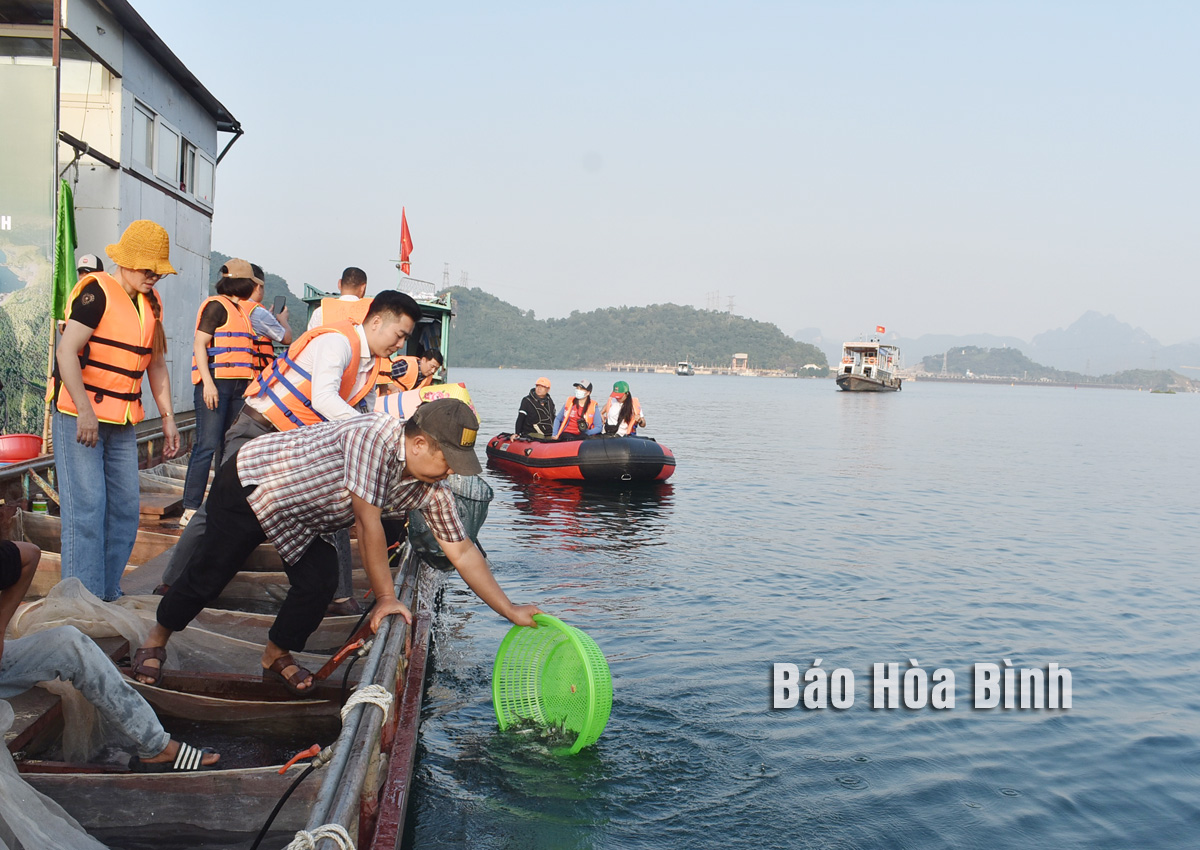
After the construction of the Da River dam, Hoa Binh Reservoir became the largest artificial lake in Vietnam, stretching 230km from Hoa Binh province to Son La province.
Located within Hoa Binh province, the reservoir spans the administrative boundaries of Hoa Binh city and four districts: Da Bac, Cao Phong, Tan Lac, and Mai Chau.
Annually, the
Fisheries Sub-Department (under the Department of Agriculture and Environment)
collaborates with various agencies and enterprises to release tonnes of fish
fry into Hoa Binh Reservoir to regenerate aquatic resources.
With its vast surface area and a capacity of over 9 billion cubic
metres, Hoa Binh Reservoir is considered a valuable treasure trove of aquatic
life and fisheries resources. According to research, the reservoir is home to
123 species from 79 genera and 19 families, including many rare, economically
valuable species with scientific research significance. The diverse and
abundant aquatic resources have provided a long-term livelihood for the local
residents around the reservoir. However, in recent years, destructive fishing methods,
such as the use of explosives and electricity, have posed serious risks to the
reservoir’s ecosystem.
Nguyen Huy Nhuan, Director of the Department of
Agriculture and Environment said to effectively harness the potential of the
area and sustainably manage and protect fisheries resources, the agricultural
sector has advised the provincial Party Committee and People’s Committee to
issue directives and policies on fish farming in the Da River Reservoir and
other large reservoirs.
The provincial administration has paid special
attention to planning, developing policies to encourage fisheries, and
protecting and regenerating aquatic resources while maintaining ecosystem
balance and providing livelihoods for local communities. Additionally, local
authorities are tasked with preventing illegal fishing methods, ensuring a
healthy environment for aquatic species. To replenish fish stocks, the province
annually allocates budget and encourages businesses to release large quantities
of fish fry into the natural environment.
According to Executive Director of Hai Dang
Group Fisheries Co., Ltd. Nguyen Thi Dung, in addition to producing,
processing, cultivating, and trading fish products, the company annually
allocates funds for releasing different fish species to diversify and
regenerate aquatic resources in the reservoir area.
Alongside efforts to restock aquatic resources,
environmental protection has been a key focus. Relevant authorities and
localities have ramped up awareness campaigns to educate people on the
importance of protecting fisheries resources and the habitats of aquatic
species, both in the wild and in aquaculture. Local residents are encouraged to
comply with legal regulations, avoid using electric shocks, toxins, or
explosives in fishing, and only fish during authorised seasons and within the
legal size limits. Routine patrols and inspections are conducted to promptly
detect and address violations, while raising public awareness of legal
requirements for aquaculture.
Nguyen Van Chieu, Deputy Chairman of the Hoa
Binh commune People's Committee, Hoa Binh city, noted that the commune has two
villages along the reservoir. Local police and military forces have worked to
inform and persuade the public to avoid prohibited substances and harmful
fishing equipment, helping people understand that protecting fisheries
resources in the reservoir area is essential for preserving their own
livelihoods.
In protecting fisheries, local authorities
strengthen checks and punishments for violations such as using explosives,
electricity, or toxins for fishing. They promptly confiscate illegal equipment
and work to conserve and protect aquatic ecosystems and endangered, rare
species. Training sessions and campaigns on the Fisheries Law and related
regulations are regularly organised, guiding residents on how to avoid
introducing invasive aquatic species that could harm the environment, thus
fostering greater public awareness of efforts to protect, regenerate, and
develop fisheries resources.
Dao Village’s honey – a product certified with a 3-star OCOP (One Commune One Product) rating by Thong Nhat Agricultural Cooperative in Dao Village (Hoa Binh City) – is highly regarded by consumers for its quality, richness, and variety in packaging. The distinctively sweet taste of Dao Village’s honey leaves a lasting impression on anyone who has tried it.
In alignment with Project No. 07-DA/TU, issued by the Hoa Binh provincial Party Committee on November 1, 2021, Lac Thuy district has actively promoted investment and supported the sustainable development of its industrial and handicraft sectors during the 2021–2025 period. Alongside this, the district has remained committed to preserving and revitalising traditional craft villages.
Located in the northern part of Lac Thuy district, with a temperate climate and fertile soil, Phu Thanh commune has great potential and advantages in growing tea. The long-standing experience, combined with strict adherence to organic farming practices in the tea gardens, ensures that the dried tea products from Phu Thanh and Lac Thuy as a whole are sold out immediately upon production, providing a stable and prosperous life for the local people.
Amid efforts to streamline the administrative apparatus, Hoa Binh province has intensified measures to address challenges in land clearance, resettlement support, and infrastructure investment, aiming to speed up the progress of key projects.
Hoa Binh province has posted an unprecedented economic growth rate of 12.76% in the first quarter of 2025, marking its highest quarterly performance to date and positioning it as the second fastest-growing locality in the country, trailing only Bac Giang province.
Under current regulations, products in the One Commune – One Product (OCOP) programme that are rated three stars or higher must undergo re-evaluation every three months. However, in reality, some of these products fail to consistently meet the required standards, raising concerns about the sustainability of their OCOP certification. This underscores the urgent need for producers to enhance product quality and gradually develop their OCOP products into strong, marketable brands.



